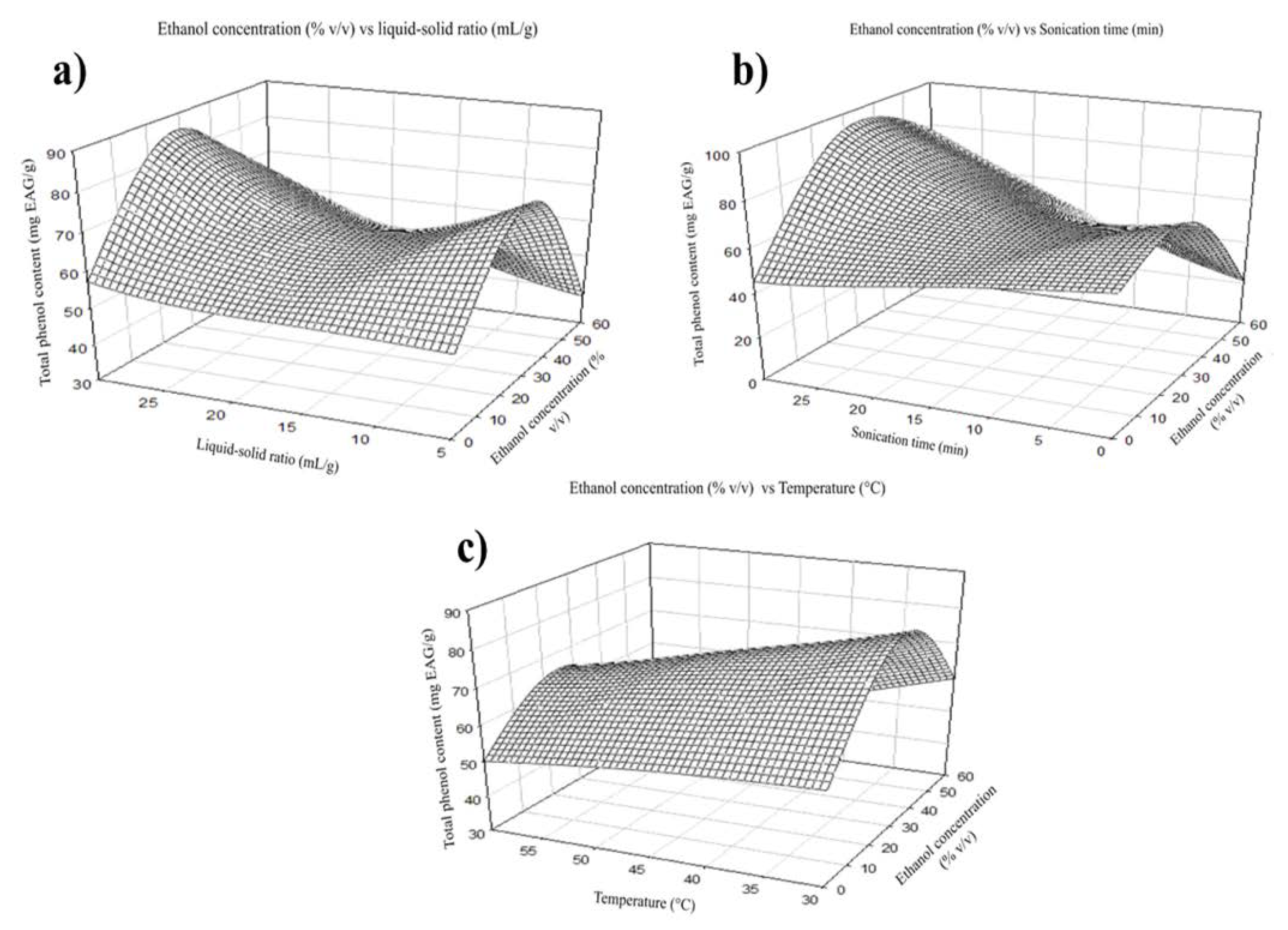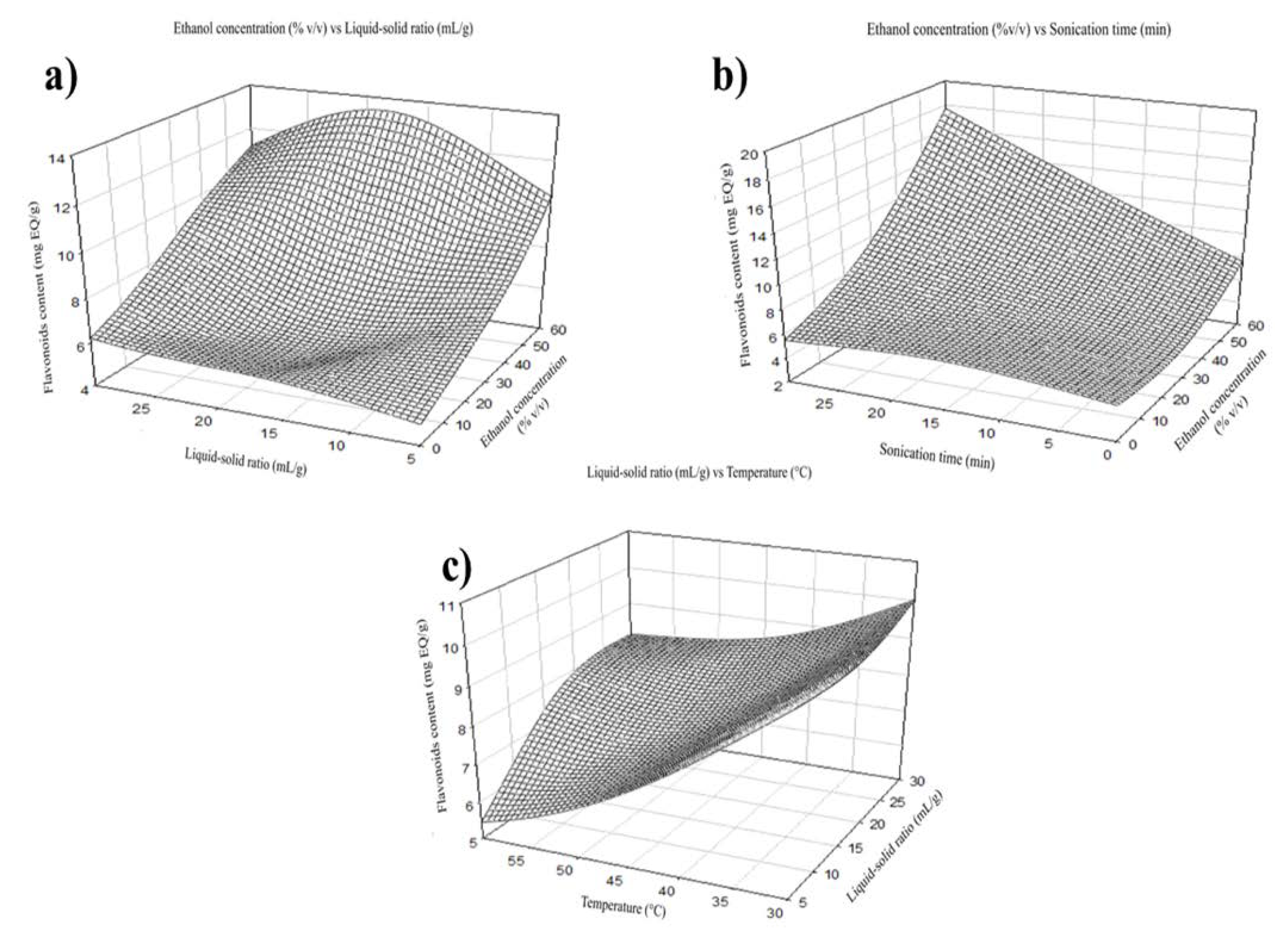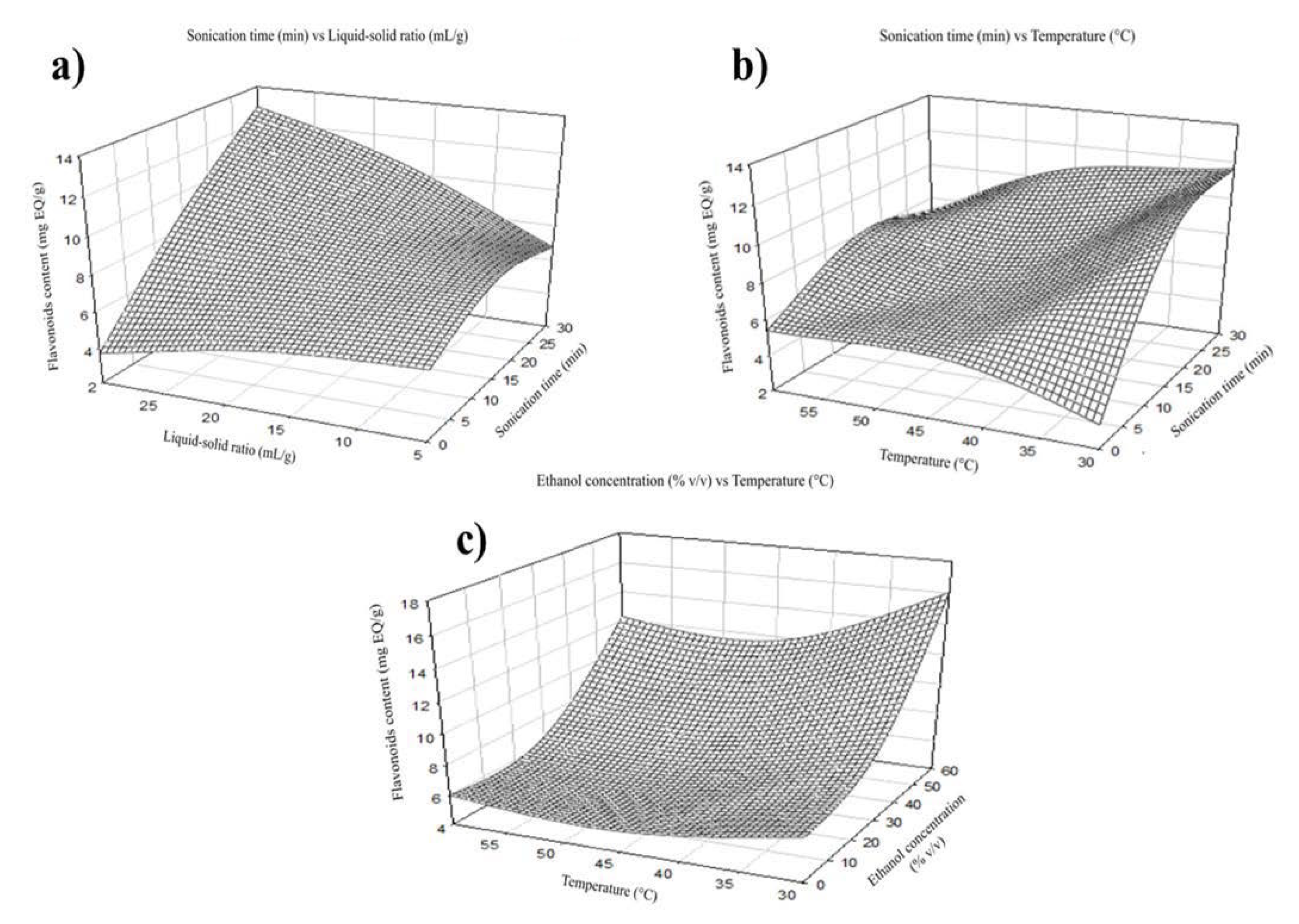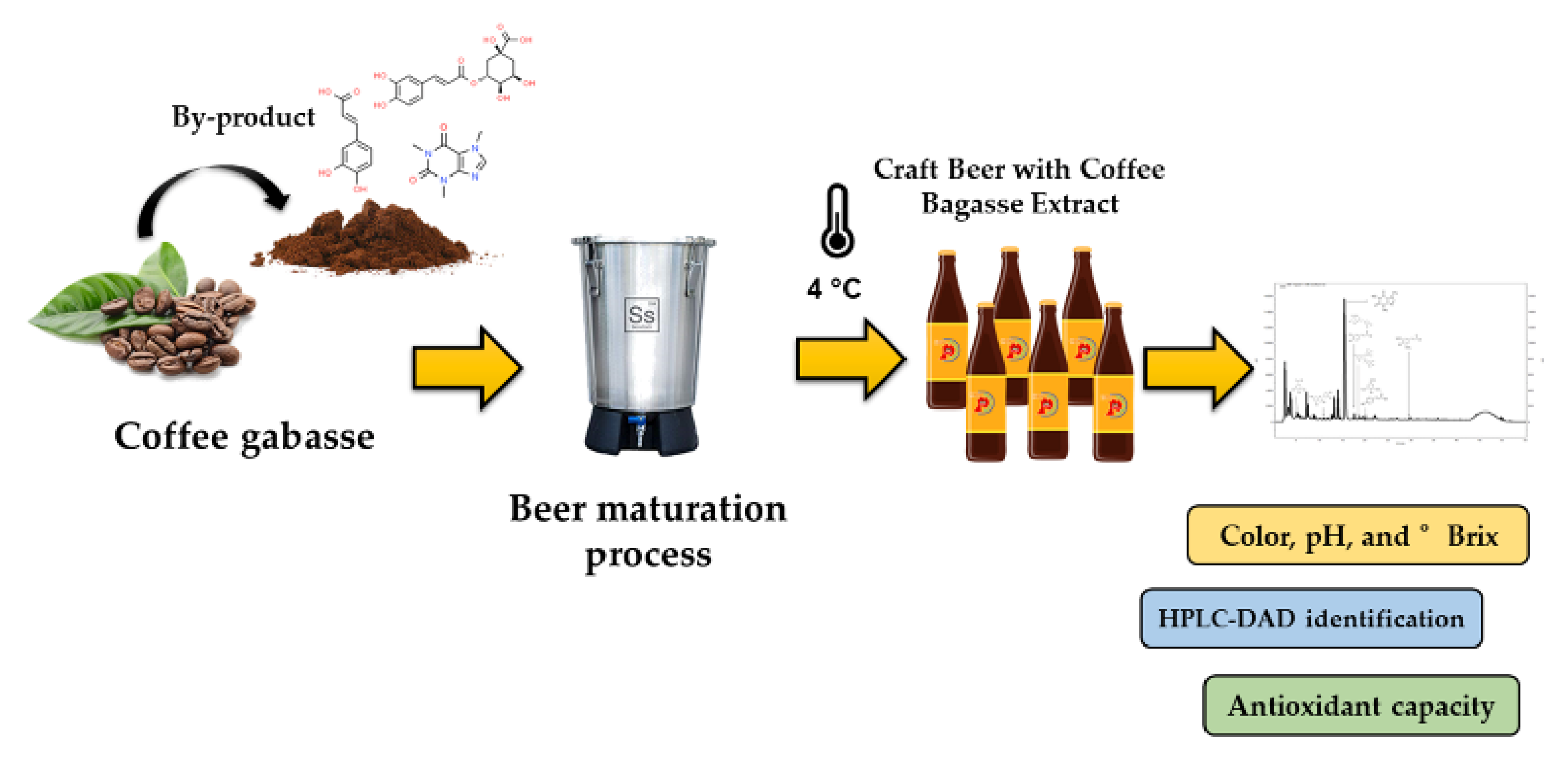Use of Coffee Bean Bagasse Extracts in the Brewing of Craft Beers: Optimization and Antioxidant Capacity
Abstract
:1. Introduction
2. Results
2.1. Total Phenol and Flavonoid Content
2.2. Effect of Independent Variables on the Total Extraction of Phenolic Compounds
2.2.1. Effect of Ethanol Concentration
2.2.2. Effect of Temperature, Liquid-Solid Ratio, and Sonication Time
2.3. Identification of Phenolic Compounds by HPLC-DAD
2.4. Brewing Craft Beer with Coffee Bean Bagasse Extract
pH and °Brix of Craft Beer
2.5. Color of Craft Beer with Coffee Bean Bagasse Extract
2.6. Content of Phenols, Flavonoids Totals, and Antioxidant Capacity of Craft Beer with Coffee Bean Bagasse Extract
3. Discussion
4. Materials and Methods
4.1. Samples
4.2. Chemicals
4.3. Drying and Storage of Coffee Bean Bagasse
4.4. Optimization of Coffee Bean Bagasse Extraction Parameters
4.5. Craft Beer Production with Coffee Bean Bagasse Extract
Craft Beer Production Process
4.6. Color of Craft Beer and Craft Beer with Coffee Bean Bagasse Extract
4.7. Flavonoid and Phenols Total Assay
4.8. DPPH• Assay
4.9. FRAP Assay
4.10. Identification and Quantification of Phenolic Compounds by HPLC-DAD
4.11. Experimental Design and Statistical Analysis
4.12. Statistical Analysis
5. Conclusions
Supplementary Materials
Author Contributions
Funding
Institutional Review Board Statement
Informed Consent Statement
Data Availability Statement
Acknowledgments
Conflicts of Interest
Sample Availability
References
- Durán-Aranguren, D.D.; Robledo, S.; Gomez-Restrepo, E.; Valencia, J.W.A.; Tarazona, N.A. Scientometric Overview of Coffee By-Products and Their Applications. Molecules 2021, 26, 7605. [Google Scholar] [CrossRef]
- Statistical Yearbook of Agricultural Production; Agrifood and Fisheries Information Service (SIAP) Home Page. Available online: https://nube.siap.gob.mx/cierreagricola/ (accessed on 30 May 2022).
- Klingel, T.; Kremer, J.I.; Gottstein, V.; De Rezende, T.R.; Schwarz, S.; Lachenmeier, D.W. A Review of Coffee By-Products Including Leaf, Flower, Cherry, Husk, Silver Skin, and Spent Grounds as Novel Foods within the European Union. Foods 2020, 9, 665. [Google Scholar] [CrossRef] [PubMed]
- Prandi, B.; Ferri, M.; Monari, S.; Zurlini, C.; Cigognini, I.; Verstringe, S.; Schaller, D.; Walter, M.; Navarini, L.; Tassoni, A.; et al. Extraction and Chemical Characterization of Functional Phenols and Proteins from Coffee (Coffea arabica) By-Products. Biomolecules 2021, 11, 1571. [Google Scholar] [CrossRef] [PubMed]
- Herawati, D.; Giriwono, P.E.; Dewi, F.N.A.; Kashiwagi, T.; Andarwulan, N. Critical roasting level determines bioactive content and antioxidant activity of Robusta coffee beans. Food Sci. Biotechnol. 2018, 28, 7–14. [Google Scholar] [CrossRef] [PubMed]
- Alves, R.C.; Rodrigues, F.; Nunes, M.A.; Vinha, A.F.; Oliveira, M.B.P. State of the art in coffee processing by-products. In Handbook of Coffee Processing By-Products; Elsevier: Amsterdam, The Netherlands, 2017; pp. 1–26. [Google Scholar]
- Rochín-Medina, J.J.; Ramírez, K.; Rangel-Peraza, J.G.; Bustos-Terrones, Y.A. Increase of content and bioactivity of total phenolic compounds from spent coffee grounds through solid state fermentation by Bacillus clausii. J. Food Sci. Technol. 2018, 55, 915–923. [Google Scholar] [CrossRef] [PubMed]
- Carpena, M.; da Pereira, R.; Garcia-Perez, P.; Otero, P.; Soria-Lopez, A.; Chamorro, F.; Alcaide-Sancho, J.; Fraga-Corral, M.; Prieto, M.A.; Simal-Gandara, J. An Overview of Food Bioactive Compounds and Their Properties. In Membrane Separation of Food Bioactive Ingredients; Springer: Cham, Switzerland, 2021; pp. 39–79. [Google Scholar]
- Maniglia, B.C.; Rebelatto, E.A.; Andrade, K.S.; Zielinski, A.; Andrade, C.J.D. Polyphenols. In Food Bioactives and Health; Springer: Cham, Switzerland, 2021; pp. 1–39. [Google Scholar]
- Zeb, A. Concept of Antioxidants in Foods. In Phenolic Antioxidants in Foods: Chemistry, Biochemistry and Analysis; Springer: Cham, Switzerland, 2021; pp. 3–23. [Google Scholar]
- Salanță, L.C.; Coldea, T.E.; Ignat, M.V.; Pop, C.R.; Tofană, M.; Mudura, E.; Borșa, A.; Pasqualone, A.; Zhao, H. Non-Alcoholic and Craft Beer Production and Challenges. Processes 2020, 8, 1382. [Google Scholar] [CrossRef]
- Ambra, R.; Pastore, G.; Lucchetti, S. The Role of Bioactive Phenolic Compounds on the Impact of Beer on Health. Molecules 2021, 26, 486. [Google Scholar] [CrossRef]
- Pai, T.V.; Sawant, S.Y.; Ghatak, A.A.; Chaturvedi, P.A.; Gupte, A.M.; Desai, N.S. Characterization of Indian beers: Chemical composition and antioxidant potential. J. Food Sci. Technol. 2013, 52, 1414–1423. [Google Scholar] [CrossRef] [Green Version]
- Zhao, H.; Chen, W.; Lu, J.; Zhao, M. Phenolic profiles and antioxidant activities of commercial beers. Food Chem. 2010, 119, 1150–1158. [Google Scholar] [CrossRef]
- Gasiński, A.; Kawa-Rygielska, J.; Szumny, A.; Czubaszek, A.; Gąsior, J.; Pietrzak, W. Volatile compounds content, physicochemical parameters, and antioxidant activity of beers with addition of mango fruit (Mangifera indica). Molecules 2020, 25, 3033. [Google Scholar] [CrossRef]
- Deng, Y.; Lim, J.; Nguyen, T.T.H.; Mok, I.-K.; Piao, M.; Kim, D. Composition and biochemical properties of ale beer enriched with lignans from Schisandra chinensis Baillon (omija) fruits. Food Sci. Biotechnol. 2020, 29, 609–617. [Google Scholar] [CrossRef] [PubMed]
- Nour, V.; Trandafir, I.; Cosmulescu, S. Antioxidant capacity, phenolic compounds and minerals content of blackcurrant (Ribes nigrum L.) leaves as influenced by harvesting date and extraction method. Ind. Crop. Prod. 2014, 53, 133–139. [Google Scholar] [CrossRef]
- Solomakou, N.; Loukri, A.; Tsafrakidou, P.; Michaelidou, A.-M.; Mourtzinos, I.; Goula, A.M. Recovery of phenolic compounds from spent coffee grounds through optimized extraction processes. Sustain. Chem. Pharm. 2022, 25, 100592. [Google Scholar] [CrossRef]
- Lukinac, J.; Mastanjević, K.; Mastanjević, K.; Nakov, G.; Jukić, M. Computer Vision Method in Beer Quality Evaluation—A Review. Beverages 2019, 5, 38. [Google Scholar] [CrossRef] [Green Version]
- Baigts-Allende, D.K.; Pérez-Alva, A.; Ramírez-Rodrigues, M.A.; Palacios, A.; Ramírez-Rodrigues, M.M. A comparative study of polyphenolic and amino acid profiles of commercial fruit beers. J. Food Compos. Anal. 2021, 100, 103921. [Google Scholar] [CrossRef]
- Torres-Valenzuela, L.S.; Ballesteros-Gómez, A.; Rubio, S. Supramolecular solvent extraction of bioactives from coffee cherry pulp. J. Food Eng. 2020, 278, 109933. [Google Scholar] [CrossRef]
- He, B.; Zhang, L.-L.; Yue, X.-Y.; Liang, J.; Jiang, J.; Gao, X.-L.; Yue, P.-X. Optimization of Ultrasound-Assisted Extraction of phenolic compounds and anthocyanins from blueberry (Vaccinium ashei) wine pomace. Food Chem. 2016, 204, 70–76. [Google Scholar] [CrossRef]
- Toma, M.; Vinatoru, M.; Paniwnyk, L.; Mason, T. Investigation of the effects of ultrasound on vegetal tissues during solvent extraction. Ultrason. Sonochemistry 2001, 8, 137–142. [Google Scholar] [CrossRef]
- Liu, Y.; Wei, S.; Liao, M. Optimization of ultrasonic extraction of phenolic compounds from Euryale ferox seed shells using response surface methodology. Ind. Crop. Prod. 2013, 49, 837–843. [Google Scholar] [CrossRef]
- Mokrani, A.; Madani, K. Effect of solvent, time and temperature on the extraction of phenolic compounds and antioxidant capacity of peach (Prunus persica L.) fruit. Sep. Purif. Technol. 2016, 162, 68–76. [Google Scholar] [CrossRef]
- Oroian, M.; Ursachi, F.; Dranca, F. Influence of ultrasonic amplitude, temperature, time and solvent concentration on bioactive compounds extraction from propolis. Ultrason. Sonochemistry 2020, 64, 105021. [Google Scholar] [CrossRef]
- Nitthikan, N.; Leelapornpisid, P.; Natakankitkul, S.; Chaiyana, W.; Mueller, M.; Viernstein, H.; Kiattisin, K. Improvement of Stability and Transdermal Delivery of Bioactive Compounds in Green Robusta Coffee Beans Extract Loaded Nanostructured Lipid Carriers. J. Nanotechnol. 2018, 2018, 7865024. [Google Scholar] [CrossRef] [Green Version]
- Vinson, J.A.; Chen, X.; Garver, D.D. Determination of Total Chlorogenic Acids in Commercial Green Coffee Extracts. J. Med. Food 2019, 22, 314–320. [Google Scholar] [CrossRef] [PubMed]
- Pearson, J.L.; Lee, S.; Suresh, H.; Low, M.; Nang, M.; Singh, S.; Lamin, F.; Kazzem, M.; Sullivan, S.; Khoo, C.S. The Liquid Chromatographic Determination of Chlorogenic and Caffeic Acids in Xu Duan (Dipsacus asperoides) Raw Herb. ISRN Anal. Chem. 2014, 2014, 968314. [Google Scholar] [CrossRef] [Green Version]
- Arai, K.; Terashima, H.; Aizawa, S.-I.; Taga, A.; Yamamoto, A.; Tsutsumiuchi, K.; Kodama, S. Simultaneous Determination of Trigonelline, Caffeine, Chlorogenic Acid and Their Related Compounds in Instant Coffee Samples by HPLC Using an Acidic Mobile Phase Containing Octanesulfonate. Anal. Sci. 2015, 31, 831–835. [Google Scholar] [CrossRef] [Green Version]
- Viana, A.C.; Pimentel, T.C.; do Vale, R.B.; Clementino, L.S.; Ferreira, E.T.J.; Magnani, M.; dos Santos Lima, M. American pale Ale craft beer: Influence of brewer’s yeast strains on the chemical composition and antioxidant capacity. LWT 2021, 152, 112317. [Google Scholar] [CrossRef]
- Cortese, M.; Gigliobianco, M.R.; Peregrina, D.V.; Sagratini, G.; Censi, R.; Di Martino, P. Quantification of phenolic compounds in different types of crafts beers, worts, starting and spent ingredients by liquid chromatography-tandem mass spectrometry. J. Chromatogr. A 2020, 1612, 460622. [Google Scholar] [CrossRef]
- Leitao, C.; Marchioni, E.; Bergaentzlé, M.; Zhao, M.; Didierjean, L.; Taidi, B.; Ennahar, S. Effects of Processing Steps on the Phenolic Content and Antioxidant Activity of Beer. J. Agric. Food Chem. 2011, 59, 1249–1255. [Google Scholar] [CrossRef]
- Coulibaly, W.H.; Bouatenin, K.M.J.-P.; Boli, Z.B.I.A.; Alfred, K.K.; Bi, Y.C.T.; N’Sa, K.M.C.; Cot, M.; Djameh, C.; Djè, K.M. Influence of yeasts on bioactive compounds content of traditional sorghum beer (tchapalo) produced in Côte d’Ivoire. Curr. Res. Food Sci. 2020, 3, 195–200. [Google Scholar] [CrossRef] [PubMed]
- Esslinger, H.M. (Ed.) Handbook of Brewing: Processes, Technology, Markets; John Wiley & Sons: New York, NY, USA, 2009. [Google Scholar]
- Granato, D.; Branco, G.F.; Faria, J.D.A.F.; Cruz, A.G. Characterization of Brazilian lager and brown ale beers based on color, phenolic compounds, and antioxidant activity using chemometrics. J. Sci. Food Agric. 2011, 91, 563–571. [Google Scholar] [CrossRef]
- Prior, R.L.; Wu, X.; Schaich, K. Standardized Methods for the Determination of Antioxidant Capacity and Phenolics in Foods and Dietary Supplements. J. Agric. Food Chem. 2005, 53, 4290–4302. [Google Scholar] [CrossRef]
- Costa, A.S.; Alves, R.C.; Vinha, A.F.; Barreira, S.V.; Nunes, M.A.; Cunha, L.M.; Oliveira, M.B.P. Optimization of antioxidants extraction from coffee silverskin, a roasting by-product, having in view a sustainable process. Ind. Crop. Prod. 2014, 53, 350–357. [Google Scholar] [CrossRef]
- Van Strien, J.; Drost, B.W. Photometric Determination of Beer and Wort Colors. J. Am. Soc. Brew. Chem. 1979, 37, 84–88. [Google Scholar] [CrossRef]
- Kumaran, A.; Karunakaran, R.J. In vitro antioxidant activities of methanol extracts of five Phyllanthus species from India. LWT-Food Sci. Technol. 2007, 40, 344–352. [Google Scholar] [CrossRef]
- Singleton, V.L.; Rossi, J.A. Colorimetry of total phenolics with phosphomolybdic-phosphotungstic acid reagents. Am. J. Enol. Vitic. 1965, 16, 144–158. [Google Scholar]
- Re, R.; Pellegrini, N.; Proteggente, A.; Pannala, A.; Yang, M.; Rice-Evans, C. Antioxidant activity applying an improved ABTS radical cation decolorization assay. Free Radic. Biol. Med. 1999, 26, 1231–1237. [Google Scholar] [CrossRef]
- Benzie, I.F.F.; Strain, J.J. The ferric reducing ability of plasma (FRAP) as a measure of “antioxidant power”: The FRAP assay. Anal. Biochem. 1996, 239, 70–76. [Google Scholar] [CrossRef] [Green Version]
- Cantos, E.; García-Viguera, C.; de Pascual-Teresa, S.; Tomás-Barberán, F.A. Effect of Postharvest Ultraviolet Irradiation on Resveratrol and Other Phenolics of Cv. Napoleon Table Grapes. J. Agric. Food Chem. 2000, 48, 4606–4612. [Google Scholar] [CrossRef]





| Independent Variable | Response Variable | |||||||
|---|---|---|---|---|---|---|---|---|
| Run | EtOH (% v/v) | Temperature (°C) | Solid/Liquid Ratio (mL/g) | Sonication Time (min) | Total Phenols Content (mg GAE/g DW) | Flavonoids Content (mg QE/g DW) | DPPH• (μMol TE/g DW) | FRAP (μMol TE/g DW) |
| 1 | 30 | 45 | 5.0 | 30 | 89.91 ± 1.11 | 6.76 ± 0.22 | 4.71 ± 2.28 | 29.83 ± 3.08 |
| 2 | 30 | 45 | 30.0 | 0 | 68.60 ± 3.76 | 4.58 ± 0.09 | 15.86 ± 0.64 | 15.38 ± 4.93 |
| 3 | 60 | 60 | 17.5 | 15 | 32.79 ± 0.02 | 12.25 ± 0.08 | 9.44 ± 1.79 | 20.35 ± 2.19 |
| 4 | 60 | 45 | 17.5 | 30 | 77.79 ± 0.28 | 17.72 ± 0.04 | 28.10 ± 2.59 | 30.02 ± 4.20 |
| 5 | 30 | 45 | 30.0 | 30 | 112.08 ± 2.81 | 12.88 ± 0.19 | 28.78 ± 2.48 | 26.94 ± 2.56 |
| 6 | 0 | 45 | 30.0 | 15 | 57.15 ± 2.73 | 6.23 ± 0.16 | 18.62 ± 0.99 | 16.06 ± 2.21 |
| 7 | 30 | 30 | 5.0 | 15 | 82.35 ± 1.02 | 9.64 ± 0.13 | 26.73 ± 2.84 | 29.85 ± 5.86 |
| 8 | 30 | 60 | 30.0 | 15 | 76.57 ± 0.24 | 8.11 ± 0.04 | 12.80 ± 2.61 | 31.01 ± 1.60 |
| 9 | 30 | 45 | 5.0 | 0 | 85.82 ± 2.11 | 5.82 ± 0.84 | 27.28 ± 1.80 | 27.37 ± 0.20 |
| 10 | 30 | 45 | 17.5 | 15 | 53.23 ± 1.41 | 5.32 ± 0.13 | 16.78 ± 1.96 | 16.05 ± 2.31 |
| 11 | 60 | 45 | 30.0 | 15 | 50.40 ± 0.33 | 11.16 ± 0.09 | 8.19 ± 1.32 | 17.74 ± 2.88 |
| 12 | 30 | 30 | 30.0 | 15 | 85.98 ± 3.01 | 10.02 ± 0.03 | 30.58 ± 4.47 | 53.16 ± 3.63 |
| 13 | 60 | 30 | 17.5 | 15 | 59.77 ± 2.80 | 16.05 ± 0.38 | 23.24 ± 1.83 | 35.41 ± 1.44 |
| 14 | 60 | 45 | 5.0 | 15 | 38.11 ± 2.36 | 10.39 ± 0.21 | 13.88 ± 1.87 | 15.55 ± 3.85 |
| 15 | 0 | 45 | 17.5 | 0 | 62.09 ± 2.65 | 4.89 ± 0.05 | 18.07 ± 1.30 | 28.79 ± 4.74 |
| 16 | 30 | 45 | 17.5 | 15 | 53.23 ± 1.41 | 5.32 ± 0.13 | 16.78 ± 1.96 | 16.05 ± 2.31 |
| 17 | 60 | 45 | 17.5 | 0 | 21.39 ± 0.96 | 7.62 ± 0.14 | 29.19 ± 0.75 | 29.43 ± 5.96 |
| 18 | 30 | 30 | 17.5 | 30 | 115.42 ± 1.04 | 11.64 ± 0.04 | 39.64 ± 2.65 | 55.51 ± 6.66 |
| 19 | 0 | 45 | 17.5 | 30 | 45.34 ± 1.08 | 5.49 ± 0.10 | 13.89 ± 2.16 | 13.21 ± 2.72 |
| 20 | 0 | 45 | 5.0 | 15 | 52.26 ± 0.34 | 4.94 ± 0.06 | 28.29 ± 0.30 | 20.46 ± 2.87 |
| 21 | 30 | 60 | 17.5 | 0 | 76.44 ± 1.78 | 5.40 ± 0.02 | 15.26 ± 0.01 | 17.62 ± 6.09 |
| 22 | 30 | 45 | 17.5 | 15 | 53.23 ± 1.41 | 5.32 ± 0.13 | 16.78 ± 1.96 | 16.05 ± 2.31 |
| 23 | 0 | 30 | 17.5 | 15 | 56.15 ± 0.66 | 6.80 ± 0.57 | 16.59 ± 1.18 | 25.00 ± 2.39 |
| 24 | 30 | 30 | 17.5 | 0 | 48.00 ± 0.62 | 3.32 ± 0.02 | 8.84 ± 0.92 | 12.35 ± 3.26 |
| 25 | 0 | 60 | 17.5 | 15 | 50.00 ± 1.79 | 5.97 ± 0.12 | 26.07 ± 0.74 | 21.02 ± 2.13 |
| 26 | 30 | 60 | 17.5 | 30 | 55.39 ± 1.64 | 7.16 ± 0.06 | 7.87 ± 1.08 | 15.87 ± 1.35 |
| 27 | 30 | 60 | 5.0 | 15 | 50.00 ± 3.89 | 5.45 ± 0.08 | 10.59± 1.02 | 11.89 ± 1.78 |
| Samples | |||||
|---|---|---|---|---|---|
| Compounds | Retention Time (min) | Absorbance Wavelength (λ max in nm) | Optimized Coffee Bean Bagasse Extract | Craft Beer (Control) | Craft Beer with Coffee Bean Bagasse Extract (S10) |
| Gallic acid | 5.0 | 280 | 477.17 ± 0.48 | 268.00 ± 4.49 | 153.98 ± 9.09 |
| Catechin | 10.8 | 280 | ND * | 77.71 ± 5.17 | 395.73 ± 5.65 |
| Caffeine | 15.6 | 280 | 5526.55 ± 35.86 | ND * | 12,528.31 ± 63.41 |
| Caffeic acid | 17.3 | 280 | 122.89 ± 2.68 | ND * | 130.58 ± 2.69 |
| Epigallocatechin gallate | 17.4 | 280 | ND * | 140.75 ± 4.16 | 731.73 ± 3.18 |
| Chlorogenic acid | 17.6 | 280 | 129.33 ± 4.92 | ND * | 227.27 ± 2.03 |
| Epicatechin | 18.7 | 280 | ND * | 213.26 ± 5.58 | 776.00 ± 0.02 |
| Syringic acid | 20.2 | 280 | 108.09 ± 0.86 | ND * | 77.88 ± 1.24 |
| p-coumaric acid | 20.4 | 280 | 261.11 ± 0.16 | 53.72 ± 0.18 | 114.64 ± 9.94 |
| Sinapic acid | 29.9 | 280 | 24.27 ± 0.07 | ND * | 30.48 ± 1.53 |
| Sample | Color (°SMR) | Total Phenol Content (mg of GAE/g DW) | Flavonoid Content (mg of QE/g DW) | DPPH• (μMol of TE/g DW) | FRAP (μMol of TE/g DW) |
|---|---|---|---|---|---|
| Control | 41.00 ± 0.05 a | 13.26 ± 0.94 a | 4.20 ± 0.48 a | 1.54 ± 0.14 a | 4.36 ± 0.49 a |
| S1 | 41.41 ± 0.30 a | 537.30 ± 7.24 b | 263.81 ± 4.19 b | 110.10 ± 2.44 b | 246.71 ± 13.89 b |
| S5 | 41.47 ± 0.14 a | 257.80 ± 3.36 c | 88.11 ± 1.54 c | 48.20 ± 2.02 c | 89.13 ± 0.51 c |
| S10 | 41.58 ± 0.02 a | 115.01 ± 1.95 d | 52.16 ± 0.33 d | 33.31 ± 2.39 d | 55.36 ± 6.03 d |
| Factors | Levels | |||
|---|---|---|---|---|
| Independent variables | X | −1 | 0 | +1 |
| Ethanol concentration (% v/v) | X1 | 0 | 30 | 60 |
| Temperature (°C) | X1 | 30 | 45 | 60 |
| Liquid/Solid ratio (mL/g) | X2 | 5.0 | 17.5 | 30 |
| Sonication time (min) | X3 | 0 | 15 | 30 |
Publisher’s Note: MDPI stays neutral with regard to jurisdictional claims in published maps and institutional affiliations. |
© 2022 by the authors. Licensee MDPI, Basel, Switzerland. This article is an open access article distributed under the terms and conditions of the Creative Commons Attribution (CC BY) license (https://creativecommons.org/licenses/by/4.0/).
Share and Cite
Chacón-Figueroa, I.H.; Medrano-Ruiz, L.G.; Moreno-Vásquez, M.d.J.; Ovando-Martínez, M.; Gámez-Meza, N.; Del-Toro-Sánchez, C.L.; Castro-Enríquez, D.D.; López-Ahumada, G.A.; Dórame-Miranda, R.F. Use of Coffee Bean Bagasse Extracts in the Brewing of Craft Beers: Optimization and Antioxidant Capacity. Molecules 2022, 27, 7755. https://doi.org/10.3390/molecules27227755
Chacón-Figueroa IH, Medrano-Ruiz LG, Moreno-Vásquez MdJ, Ovando-Martínez M, Gámez-Meza N, Del-Toro-Sánchez CL, Castro-Enríquez DD, López-Ahumada GA, Dórame-Miranda RF. Use of Coffee Bean Bagasse Extracts in the Brewing of Craft Beers: Optimization and Antioxidant Capacity. Molecules. 2022; 27(22):7755. https://doi.org/10.3390/molecules27227755
Chicago/Turabian StyleChacón-Figueroa, Isabel H., Luis G. Medrano-Ruiz, María de Jesús Moreno-Vásquez, Maribel Ovando-Martínez, Nohemí Gámez-Meza, Carmen L. Del-Toro-Sánchez, Daniela D. Castro-Enríquez, Guadalupe A. López-Ahumada, and Ramón F. Dórame-Miranda. 2022. "Use of Coffee Bean Bagasse Extracts in the Brewing of Craft Beers: Optimization and Antioxidant Capacity" Molecules 27, no. 22: 7755. https://doi.org/10.3390/molecules27227755







